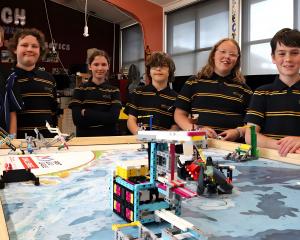An extraterrestrial traveller will be on display during this year’s NanoFest.
New Zealand’s newest meteorite was discovered in March near Lake Tekapo by a team of about 24 people led by University of Otago geologist Dr Marshall Palmer.
Dr Palmer said narrowing down the potential location of the meteorite was guided by a network of 140 cameras across the country.

"Then it enters a stage called dark flight, where it’s not bright any more, and then we have to model where it may have fallen on the ground."
Local weather modelling, as well as making assumptions regarding the shape, mass, and speed of the meteor, helped guide where it may have landed.
The meteorite, now weighing 800g, likely originated as a much larger mass, estimated to be between 10kg and 20kg before entering Earth’s atmosphere.
Dr Palmer said the meteorite’s exterior of a black, glassy melted surface was caused by the intense heat of entry.
That surface was less than a millimetre thick, and the internal rock was unaffected.
This internal surface can be seen where about 80 grams of the meteorite was sliced off using a wet diamond blade saw.
"So the reason we cut a slice off is, firstly, so you can see the internal texture, but we also took subsamples and sent those to various labs around the world for different kinds of analysis."
This will include cosmic exposure dating, which is how long the meteor has been exposed to the sun’s rays.
"That dates how long since it was broken away from the parent body."
Another test will be argon-argon dating.
"We use those to date when the parent body formed," Dr Palmer said.
Information on the composition of the meteorite can also be seen on the sliced surface.
The rock contains a mixture of iron-nickel alloy, as well as magnesium silicate minerals.
It also contains small circular-shaped balls called chondrules.
"Chondrules ... are solidified balls of what was once molten space dust."
The meteorite is what is called an ordinary chondrite, which is one of the most common types that come to Earth.
"We think, based on the classification of this, that it probably came from an asteroid that was hundreds of kilometres in diameter.
"So it’s gone through a process of metamorphism where it’s been subjected to some heat and some pressure that’s squished it together."
Dr Palmer will be presenting the meteorite at NanoFest, alongside other meteorites and related rocks.
The display will be open at the Festival Hub at Tūhura Otago Museum on Friday, July 12, and Saturday, July 13, from 10am to 3.30pm.
NanoFest
• New Zealand International Science Festival’s NanoFest runs from July 10 to 14.
• NanoFest’s Festival Hub at Tūhura Otago Museum’s H.D. Skinner Annex has a rotating selection of events each day for all the family.
• Other activities are taking place at various venues, such as coastal monitoring at the NZ Marine Studies Centre, the Art+Science Exhibition at Dunedin Community Gallery, and a talk on drones for conservation at Petridish.
• Visit scifest.org.nz for a full list of events.














